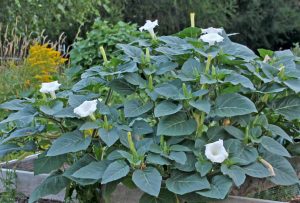
Datura are herbaceous annuals and short-lived perennials in the tomato family (Solanaceae) with a confused taxonomy and disputed origin because of their extensive naturalization through temperate and tropical regions world-wide. Of the eight or nine species in the genus Datura, many naturally exhibit extreme variability in foliar and floral characteristics and many are very similar in appearance. Depending on the conditions a plant is growing under, the size of the plant, leaves and flowers can range from very large to very small – which has led to many “new species” being described that are later found to be simply variations that developed in different locations due to the conditions.
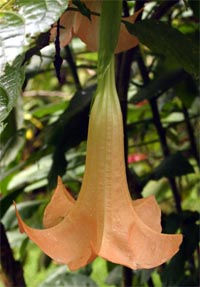
Even one of its common names, angels’s trumpet, is confusing as that is also used for the closely related genus Brugmansia, a South American group differs that from the genus Datura by having woody stems, pendant flowers and seed pods that need to be broken open. Other common names for the genus Datura include devil’s trumpets, moonflowers, and thorn-apple, with the name jimsonweed referring to D. stramonium (a common weed in pastures, roadsides and waste places throughout much of the world including the U.S. and southern Canada) and horn-of-plenty applied to D. metel.
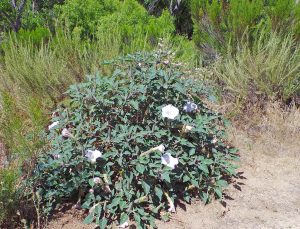
The greatest diversity of species occurs in Central America and Mexico, suggesting this as the origin of the genus, but there is ample evidence that these plants were used culturally both in the New World and in Asia as sacred plants for many millennia (at least 3,000 years). All Datura plants contain a number of alkaloids, especially in the seeds and flowers, that are toxic, narcotic and hallucinogenic. The toxicity depends on the age of the plant and growing conditions, with serious illness or death a possibility from ingestion. They are also poisonous to cattle, horses and sheep. The cultivation of Datura is banned in some states and municipalities.
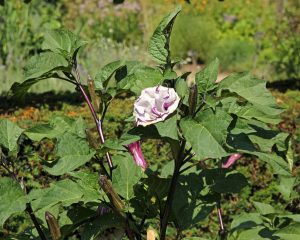
Of the nine species of Datura, only two of these herbaceous annuals/tender perennials are commonly used as ornamentals. D. inoxia, native to Central America, Mexico and the southwestern US, is the most common, along with D. metel, native to southeast Asia. The weedier D. stramonium, native to North America with smaller flowers and tooth-edged leaves, is occasionally offered as an ornamental. Even the tender perennials are fast-growing so are easily grown as seasonal annuals from seed in the Midwest.
These shrubby, sprawling warm season plants tend to grow fairly large in a single growing season. D. metel has a mounded habit and can grow 2-3 feet tall and at least as wide, if not up to twice as wide under ideal conditions and a long growing season. D. stramonium generally gets 3-4 feet tall and wide but often flops under its own weight. D. inoxia has a more upright habit with a regular branching pattern and can get up to 5 feet tall. The gray-green to dark green alternate leaves up to 10 inches long and 4 inches wide have a lobed or toothed margin. Their surfaces are either smooth (D. metel in most cases and D. stramonium) or downy (D. inoxia). The coarse-textured foliage is foul smelling when handled and the sap can cause a skin rash in sensitive individuals.
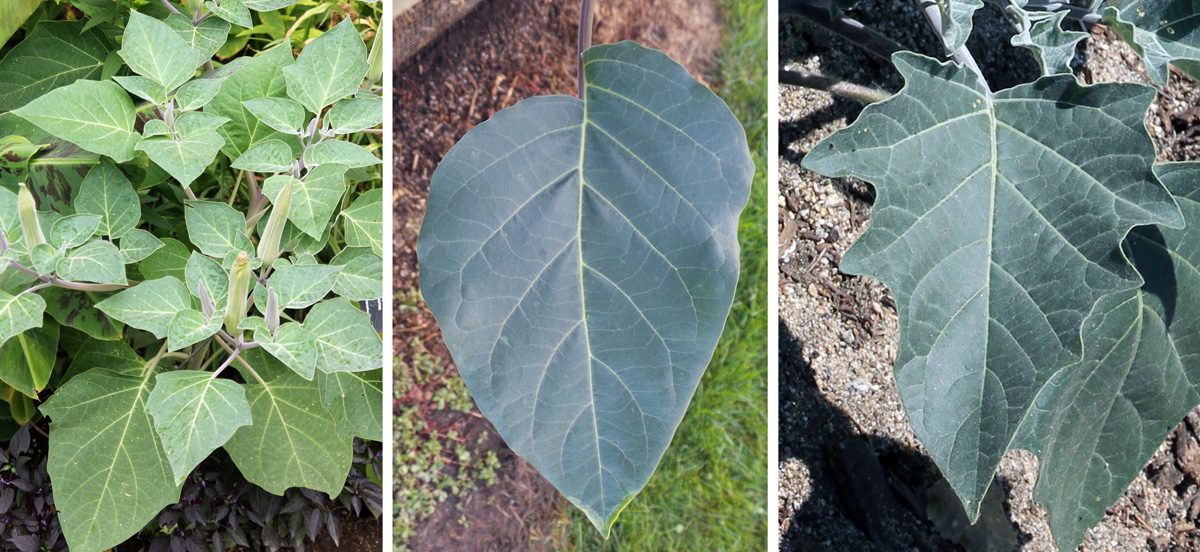
The large, erect, trumpet-shaped flowers range in color from pure white to pinkish purple, but some species have flowers that are bright golden yellow or red-purple, and some have double or triple blooms. The petals are fused to form a funnel with 5 or 10 lobes. The furled, cigar-shaped flower buds unwind after dusk (vespertine) and the flowers remain open until about noon of the following day when the petals begin to decline. The flowers exude a pleasant honeysuckle-like scent, especially at night, which attracts night-flying sphinx moths which are their primary pollinators. The flowers may also be visited by honey bees and other insects. Plants bloom continuously from summer until frost.

Flowers are followed by rounded fruits that are walnut-sized capsules that are knobby (D. metel) or covered with sharp and spiky spines at maturity (D. inoxia and D. stramonium). The capsules split open when ripe to release the numerous flattened tan or brown seeds that are similar in appearance to stout tomato seeds. Unless the seed capsules are removed before maturity, the plants tend to self-seed and can become invasive. Seeds remain viable for years.

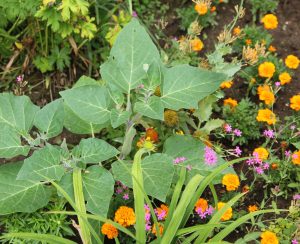
Daturas tend to be large, sprawling plants with a coarse texture, so they are best suited as specimen or background plants in mixed or annual plantings. If possible, place them where the fragrance of the dramatic flowers may be enjoyed. Those with white flowers are a natural choice for the moon garden as they are most fragrant in the evening. The bold foliage contrasts well with short ornamental grasses (such as shorter annual or perennial Pennisetums or ruby grass) and annuals with fine or medium foliage and lots of flowers, such as Profusion series zinnias or petunias.
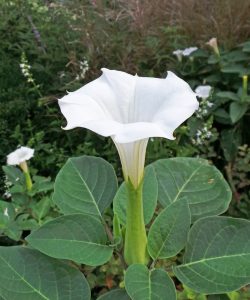
Grow datura in full sun and well-drained soil (it will grow in partial shade, but will be leggier and have fewer flowers). It is drought tolerant once established and thrives in almost any type of soil, but the plants are most impressive when grown in humus-rich loam with regular moisture.
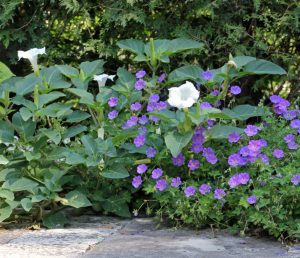
They need plenty of room and will quickly grow to fill an area of several feet once the weather gets hot so place them accordingly. They may be grow from seed sown outdoors after the last frost or started indoors 6-8 weeks before the average date of last frost and planted outdoors after all threat of frost has passed (and after acclimating the young plants to outdoor conditions).

Although they can be grown in large containers, they are generally best grown in the ground because of their size. They rarely need pruning, although stems can be cut back to shape the plants. Staking may be necessary for some plants. They have almost no pest problems, but may be infested with whiteflies, mealybugs and spider mites.
There are several cultivars and hybrids of datura (but often the species is not included when offered for sale or the same variety is listed under different names, including species names that are not scientifically accepted) including:
-
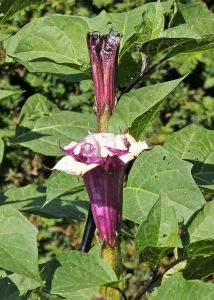
‘Purple Ballerina’ D. inoxia ‘Missouri Marble’ has variegated foliage (tinted pink with white margins), purple stems, and white and violet-purple mottled flowers that may be single or double.
- D. metel ‘Aurea’ has yellow flowers.
- D. metel Ballerina Series has swirled flowers in shades of purple, yellow and white on more compact plants.
- ‘Black Currant Swirl’ (and other names including ‘Double Purple’ and ‘Purple Hindu’) is a double or triple hybrid or variety of D. metel with flowers that are dark purple on the outside and white inside that remain open during the day but are not very fragrant.
- D. metel ‘Flore Pleno’ has double white flowers.
- Golden Queen’ is a hybrid with double, lemon-yellow frilled flowers.
– Susan Mahr, University of Wisconsin – Madison





 Marigolds
Marigolds Create a Butterfly Garden
Create a Butterfly Garden Plant Flowers to Encourage Beneficial Insects
Plant Flowers to Encourage Beneficial Insects Forcing Bulbs
Forcing Bulbs


